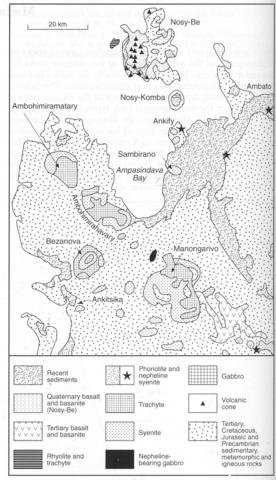stripes
Nosy-Be is an island of about 17x27 km located northeast of the Ampasindava Peninsula (No. 102-00-004). About half of the island is occupied by sedimentary rocks of Liassic age which are overlain by Quaternary volcanic rocks and intruded by two bodies of peralkaline granite, while a small island near the west coast consists mainly of rhyolite. The main area of volcanic rocks, which form the western part of the island, comprises tuffs and lavas of essentially basaltic composition that form numerous cones while some of the many craters are occupied by lakes. The volcanic rocks are referred to by Lacroix (1922a) as being principally ankaratrite, limburgite and limburgitic basanite, with ‘perhaps’ leucite-bearing rocks. The basanitic and limburgitic rocks are essentially alkali olivine basalts which are commonly rich in olivine nodules. The ankaratrites contain nepheline and an example described by Lacroix (1923) includes exceptionally abundant olivine; they would be classified as basanites in a modern nomenclature. Granite and syenite form an approximately circular body at Lokobe at the southern end of the island (Donnot, 1963), a smaller mass in the north and numerous dykes. According to Besairie (1934a) the granites are alkaline, but a description by Lacroix (1922b) indicates that this is not so. However, a syenite described by Lacroix (1922b, p. 606) is indeed peralkaline containing as it does aegirine. The syenitic rocks are said also to include solvsbergite. The rhyolite forming the island of Sakatia off the west coast of Nosy-Be contains phenocrysts of orthoclase, zircon and biotite and thus is not peralkaline.Age K-Ar on an unclassified ‘flow’ gave 7.49±026 Ma (Emerick and Duncan, 1982).
BESAIRIE, H. 1934a Notice explicative sur la Feuille Nosy-Be RS-32,33 (330). Carte Geologique de Reconnaissance à l'échelle du 200.000. Gouvernement General de Madagascar et Dependances. Tananarive.BESAIRIE, H. 1971a. Carte Géologique. Feuille 1. Diego-Suarez. 1:500,000. Service Géologique de Madagasikara, Tananarive. DONNOT, M. 1963. Les complexes intrusifs alcalins d’Ampasindava volcanisme et cristallin de l’Ankaizina (Madagascar). Annales Géologiques de Madagascar. Comptes Rendus de la Semaine Géologique 1963, 33: 81-7.EMERICK, C.M. and DUNCAN, R.A. 1982. Age progressive volcanism in the Comores Archipelago, western Indian Ocean and implications for Somali plate tectonics. Earth and Planetary Science Letters, 60: 415-28.LACROIX, A. 1922a. Minéralogie de Madagascar. 1. Géologie, minéralogie descriptive. A. Challamel, Paris. 624 pp.LACROIX, A. 1922b. Minéralogie de Madagascar. 2. Minéralogie appliquée lithologie. A. Challamel, Paris. 694 pp.LACROIX, A. 1923. Minéralogie de Madagascar. 3. Lithologie Appendice - Index Geographique. Société d’Éditions Géographiques, Maritimes et Coloniales, Paris. 450 pp.

